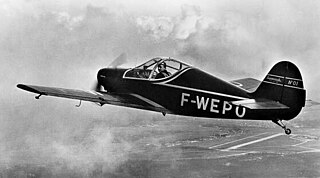Related Research Articles

The Pilatus P-3 was a military training aircraft built by Pilatus Aircraft of Switzerland.

The SAI KZ III Laerke was a Danish light utility aircraft used by the Danish Air Ambulance Service and Danish Air Force.
The Aeronca Model 9 Arrow was a low-wing all-metal cabin monoplane with retractable landing gear. It was marketed to returning pilots from World War II and unveiled in 1947 but never went into production.

The I-11 was a two-seat civil utility aircraft manufactured in Spain in the 1950s. Originally designed by the Spanish aircraft company Iberavia, its first prototype flew on 16 July 1951. It was a low-wing monoplane of conventional configuration with fixed, tricycle undercarriage and a large, bubble canopy over the two side-by-side seats. Flight characteristics were found to be pleasing, but before plans could be made for mass production, Iberavia was acquired by AISA.
The Auster Avis was a four-seat light aircraft developed from the Auster Autocrat. It featured a redesigned fuselage incorporating four doors and a circular cross-section towards the tail, new undercarriage, and new wing flaps. It was planned in two versions, the Mk 1 for civil use, and the Mk 2 for military and air ambulance duties. However, only two prototypes were built, and Auster abandoned the project in favour of the Auster J-5 Autocar.

The Avions Fairey Belfair, also known as the Tipsy Belfair after its designer, Ernest Oscar Tips, was a two-seat light aircraft built in Belgium following World War II.

The CAB GY-30 Supercab was a two-seat light aircraft built in France in 1954, as a further development of the CAB Minicab. The design was performed by Yves Gardan, a onetime employee of French aeronautical company SIPA. Changes incorporated in the Supercab included a more powerful engine, greater wingspan, manually retractable undercarriage, and slotted flaps that replaced the split flaps of the Minicab.
The Boisavia B.260 Anjou was a four-seat twin-engine light aircraft developed in France in the 1950s. It was a low-wing cantilever monoplane of conventional configuration with retractable tricycle undercarriage. Intended by Boisavia as a touring aircraft, it did not find a market and only the single prototype was constructed. At this point, the firm sold the design to SIPA, which modified the design and re-engined it with Lycoming O-360 engines, but found that they could not sell it either. At a time when the twin-engine light plane market was already dominated by all-metal American aircraft, the Anjou's fabric-over-tube construction was something of an anachronism, and all development was soon ceased. Plans to develop a stretched version with three extra seats and Potez 4D engines were also abandoned.

The Brochet MB.70 was a two-seat light aircraft developed in France in the early 1950s for recreational flying and amateur construction.

The Brochet MB.80 was a two-seat light aircraft developed in France in the early 1950s.
The Brochet MB.100 was a three-seat light aircraft developed in France in the early 1950s.

The Brochet MB.110 was a four-seat light aircraft developed in France in the early 1950s.
The Fanaero-Chile Chincol was a prototype trainer aircraft developed in Chile in 1955 for air force use. It was a conventional, low-wing cantilever monoplane of mixed construction, with fabric covered wooden wings and tail surfaces. It was fitted with a fixed tailwheel undercarriage and was powered by a single 215 horsepower (160 kW) Continental O-470 air-cooled horizontally-opposed piston engine. The pilot and instructor sat in tandem, and were enclosed under a long canopy. The prototype Chincol made its maiden flight on 14 December 1955. The Chilean Air Force responded positively to the design, and placed an order for 50 machines. However, technical problems significantly delayed manufacture, and the order was cancelled before the aircraft were produced.

The FMA 20 El Boyero ("Shepherd") was a light utility aircraft produced in Argentina in the 1940s. It was a conventional high-wing strut-braced monoplane with fixed tailskid undercarriage with seating for two side by side in an enclosed cabin.

The Macchi MB.308, later Aermacchi MB-308, was a light aircraft produced in Italy in the late 1940s, one of the most prolific Italian-built types of the following decade.
The Partenavia P.55 Tornado was a 1950s Italian high-performance competition and touring monoplane built by Partenavia. The Tornado was a small mid-wing cantilever monoplane with a retractable tricycle landing gear. The aircraft was powered by a nose-mounted Lycoming O-320 piston engine.

The SAI KZ VII Lærke was a light utility aircraft built in Denmark shortly after the Second World War. Based on the SAI KZ III air ambulance, the KZ VII was a strut-braced, high-wing monoplane of conventional design with an enclosed cabin for four seats. Fifty-six aircraft were built, and another 22 partially completed aircraft were destroyed in a factory fire in 1947. The Danish Air Force operated 10 of the type as trainers between 1950 and 1977.
The Taylorcraft Model 20 Ranch Wagon was a four-seat cabin monoplane designed and built by Taylorcraft Aircraft as a development of the earlier experimental Model 18. The Model 20 was constructed of moulded fibreglass over a tubular framework. It had a conventional landing gear and a nose-mounted 225 hp (168 kW) Continental O-470-J engine.

The Fuji LM-1 Nikko is a Japanese light communications aircraft of the 1950s.

The Ambrosini Rondone is an Italian-designed two/three-seat light touring monoplane of the early 1950s.
References
- ↑ Bridgman 1956, p. 132
- Bridgman, Leonard (1956). Jane's All The World's Aircraft 1956–57. New York: McGraw-Hill Book Company.
- Taylor, Michael J. H. (1989). Jane's Encyclopedia of Aviation. London: Studio Editions. p. 215.
- World Aircraft Information Files. London: Bright Star Publishing. pp. File 890 Sheet 99.
- Simpson, R. W. (1995). Airlife's General Aviation. Shrewsbury: Airlife Publishing. pp. 100–01.